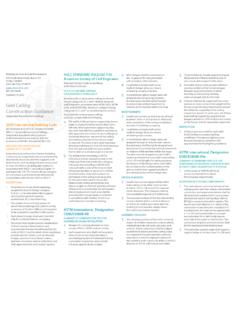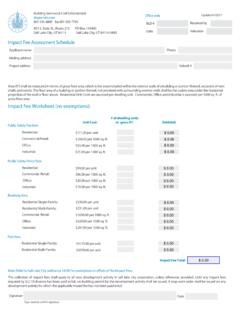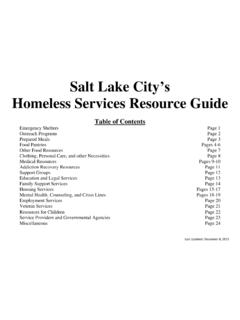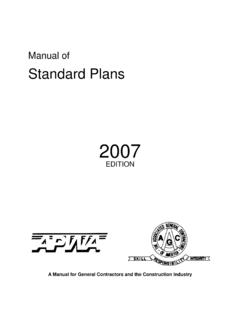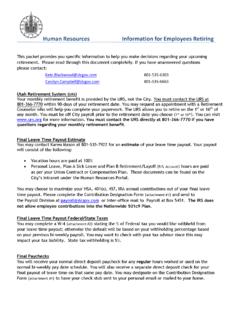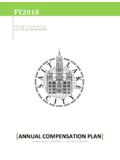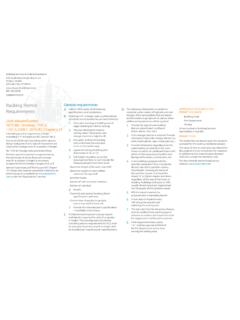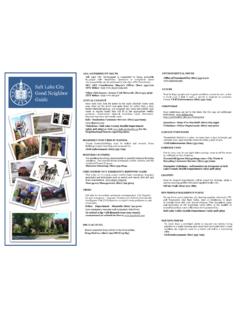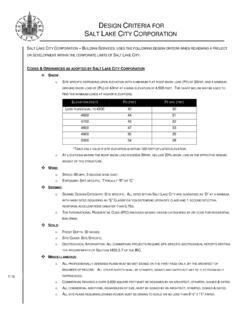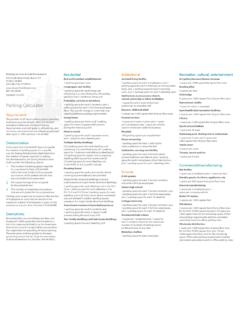Transcription of fuelbreak - slcdocs.com
1 City Creek Canyon Shaded Fuel Break Public Response - FAQ Generalized Form 1. What is a shaded fuel break? A shaded fuel break is a forest management strategy used for mitigating the threat of wildfire in areas where natural fire regimes have been suppressed, leading to a dangerous buildup of combustible vegetation. Constructing a shaded fuel break is the process of selectively thinning and removing more flammable understory vegetation while leaving the majority of larger, more fire tolerant tree species in place. 2. Why has it been proposed to construct a shaded fuel break along the City Creek Canyon road corridor this spring? A shaded fuel break is recommended as a means to provide safe ingress and egress from the canyon in the event of a fire emergency.
2 Because of the ecologically sensitive nature of the canyon, it's location to the downtown metropolitan area, and use by millions of visitors annually, other avenues of fire mitigation like controlled burns and (unshaded). fuel breaks were found to be less cost effective and not as safe. The need for the project was reconfirmed last summer when emergency crews treating a 150 acre fire in the central portion of the canyon raised concern about the safety of the road corridor in terms of accessibility. In an effort to mitigate the consequences of emergency vehicles not being able to access, or leave the canyon in the event of a fire, it was decided that the most optimal time to begin the project would be before the 2009 fire season. 3.
3 How will the shaded fuel break impact the road corridor visually? The City Creek Canyon road corridor will not look the same. While most of the larger trees that provide shade for the road will be left in place, dead wood and underbrush along the road will be removed. 4. Will all of the shade be removed from the road? No. A shaded fuel break is intended to leave the larger trees that shade the road in place while eliminating the understory that is more likely to contribute to the severity of a fire. 5. Will the understory grow back in, hence recreating the problem with fuel loading? Yes, the understory will grow back. The shaded fuel break will have to be regularly maintained to keep fuel loading under control. This first phase of the project will be more intensive than future maintenance because of the existing heavy fuel load.
4 6. Besides a shaded fuel break, are there alternatives for mitigating fire in City Creek Canyon? If so, what are those alternatives? Alternatives include using other forestry management strategies like controlled burning or a smaller, unshaded fuel break (clear cutting). However, these alternatives are not preferable. Another option is to leave the canyon as is by doing nothing which would not mitigate the current threat or consequences of a fire in the canyon or ease the impact of fire damage to the canyon in the future. 7. Will the city be mitigating the threat of catastrophic fire in the canyon by other means this summer? As in the past, the city will continue prohibiting the use of recreational fire grills and smoking in the canyon during times when fire danger is high.
5 In incorporated Salt Lake City, fire bans are determined and regulated by the Salt Lake Fire Department Chief. 8. Have any environmental analyses been conducted in the canyon prior to the break proposal? To date, environmental analysis of the canyon includes a systematic GIS survey of invasive, non-native plant species along the road. The results of these studies, as with any conducted by the city or its consultants are available for public view. The vegetation survey was conducted in 2008 by Salt Lake City watershed specialists using industry protocols and covers 200 acres of city property adjacent to the road corridor. Data from this study will be used guide the city in treating the weed infestations cost effectively, and monitoring the infestations over time.
6 9. Will any additional environmental assessments be conducted prior to the start of the study? In response to requests for more ecological study involving wildlife and habitat potential within the proposed shaded fuel break area, Public Utilities is considering pursuing additional sources of funding for these research initiatives. With community participation we hope to gather additional data about the important plant and animal habitats along the road, areas of cultural importance, sensitive areas and the potential long term consequences of any fuel reduction project. The city plans to consult with non-governmental habitat advocates, community specialists and others to provide guidance for project planning and implementation. 10. How long is the formal public input process for this project?
7 The City hopes to balance the fire threat with the community's concern for the canyon and reach mutually acceptable decisions as soon as possible. 11. Why is this project so much larger than and dissimilar to local fuel break projects? A shaded fuel break is less common than clear cut breaks which are generally narrower but remove all vegetation, not just the undergrowth. Some local projects have been smaller scale clear cut type fuel breaks. As proposed, the City Creek fuel break is a selective thinning of the roadside understory which leaves fire resistant dominant vegetation in place Local examples of fuel breaks include the cutting of all vegetation up to 15ft from the edge of pavement, which eliminates shade over the road and severely modifies the character of the canyon.
8 Shaded fuel breaks do not have this severe of an impact on the aesthetics or canopy above and near the road. 12. Does the possibility of doing a smaller demonstration project prior to the full scale project exist? Yes. The State of Utah Invasive Species Mitigation Fund has given Salt Lake City a grant which can be used to develop a demonstration project. This type of demonstration project would help the public view and provide input on the aesthetic impact a shaded fuel break might have on the canyon road corridor, although it would be insufficient to provide fire mitigation. 13. Will the fuel break contribute to the spread invasive plant species in the canyon? Disturbing the sites may allow existing noxious weed infestations to creep into the fuel break area, or it may allow for the suppressed weed seed in the area to propogate.
9 Salt Lake City has gone to great effort to survey the current invasive weed infestations so that infestations can be monitored and treated before they become a problem. Ecological restoration will be conducted throughout the fuel break where appropriate. 14. Can the cut be focused on the removal of diseased, dead and dying wood rather than living stems? Not necessarily. Living stems have the potential to contribute to the severity of a fire as much as dead wood by acting as ladder fuels. Additionally, like living stems, dead wood provides important habitat for plants and animals and it may be desirable to leave them undisturbed. A shaded fuel break is a selective process that would allow for these options. 15. What machinery will be used?
10 Chainsaws, chippers and hand tools will be used for the entirety of the process. 16. How close to the banks of the creek will the thinning and removal take place? Two thirds of the fuel break will be outside of the 100' riparian corridor. Special precautions will be made for the areas that fall within the 100' riparian corridor. Additionally, for the portion of the shaded fuel break that is within the riparian area, the 100ft. recommended cut will be minimized as it is not as necessary given the higher fuel moistures in this area as well as the existing shade. 17. Will an Environmental Impact Statement be prepared for this project? No. The road corridor is exclusively owned and managed by Salt Lake City Corporation. A federal Environmental Impact Statement or Environmental Assesment for the NEPA.
